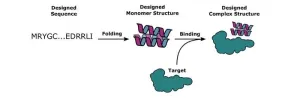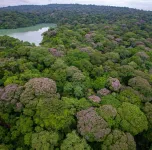(Press-News.org) Mothers who eat apples and herbs in early pregnancy could be protecting the brain health of their children and grandchildren, a Monash University study using genetic models has found.
The discovery is part of a project that found a mother’s diet can affect not just her child’s brain but also those of her grandchildren.
Published in Nature Cell Biology, the Monash Biomedicine Discovery Institute study found that certain foods could help protect against the deterioration of brain function.
More specifically, the study used roundworms (Caenorhabditis elegans) as the genetic model because many of their genes are also found conserved in humans, allowing insights into human cells.
The researchers found that a molecule present in apples and herbs (basil, rosemary, thyme, oregano, and sage) helped reduce the breakdown of communication cables needed for the brain to work properly.
Senior author Professor Roger Pocock and his team were investigating nerve cells in the brain that connect and communicate with each other through about 850,000 kilometres of cables called axons. For axons to function and survive, essential materials need to be transported along an internal structure that contains microtubules.
Professor Pocock explained that a malfunction that caused the axons to become fragile led to brain dysfunction and neurodegeneration.
He said his team used a genetic model with fragile axons that break as animals age. “We asked whether natural products found in the diet can stabilise these axons and prevent breakage,” he explained.
“We identified a molecule found in apples and herbs (ursolic acid) that reduces axon fragility. How? We found that ursolic acid causes a gene to turn on that makes a specific type of fat. This particular fat also prevented axon fragility as animals age by improving axon transport and therefore its overall health.”
Professor Pocock said this type of fat, known as a sphingolipid, had to travel from the mother’s intestine, where food is digested, to eggs in the uterus for it to protect axons in the next generation. He said while the results were promising, they still need to be confirmed in humans.
“This is the first time that a lipid/fat has been shown to be inherited,” he said. “Further, feeding the mother the sphingolipid protects the axons of two subsequent generations. This means a mother’s diet can affect not just their offspring’s brain but potentially subsequent generations. Our work supports a healthy diet during pregnancy for optimal brain development and health.”
Read the full paper published in Nature Cell Biology, titled An Intestinal Sphingolipid Confers Intergenerational Neuroprotection
DOI: 10.1038/s41556-023-01195-9
About the Monash Biomedicine Discovery Institute
Committed to making the discoveries that will relieve the future burden of disease, the Monash Biomedicine Discovery Institute (BDI) at Monash University brings together more than 120 internationally-renowned research teams. Spanning seven discovery programs across Cancer, Cardiovascular Disease, Development and Stem Cells, Infection, Immunity, Metabolism, Diabetes and Obesity, and Neuroscience, Monash BDI is one of the largest biomedical research institutes in Australia. Our researchers are supported by world-class technology and infrastructure, and partner with industry, clinicians and researchers internationally to enhance lives through discovery.
***ENDS***
END
In a new study published in Nature Geosciences, researchers, led by a Tulane University sedimentologist , investigated why the paths of meandering rivers change over time and how they could be affected by climate change.
Chenliang Wu, PhD, a postdoctoral researcher at Tulane University School of Science and Engineering, began this research by looking at the Mississippi River before adding other rivers on Earth and ancient riverbeds on Mars to the study.
The study specifically looks at river sinuosity, or how much rivers curve. The sinuosity of rivers changes over time, depending on the age of the river and environmental changes. Some of these changes ...
EAST LANSING, Mich. – Sometimes, the best place to hide a secret is in broad daylight. Just ask the sun.
“The sun is more surprising than we knew,” said Mehr Un Nisa, a postdoctoral research associate at Michigan State University. “We thought we had this star figured out, but that’s not the case.”
Nisa, who will soon be joining MSU’s faculty, is the corresponding author of a new paper in the journal Physical Review Letters that details the discovery of the highest-energy ...
Key points:
A cohort study of millions of Medicare beneficiaries found that chronic exposures to PM2.5 and NO2 over a 10-year period increased the risk of developing colorectal and prostate cancers.
Even in areas with low pollution levels, researchers found substantial associations between exposures to these pollutants and the risk of developing colorectal and prostate cancers, in addition to breast and endometrial cancers.
For immediate release: August 3, 2023
Boston, MA—Chronic exposure to fine particulate air pollutants (PM2.5) ...
MINNEAPOLIS/ST. PAUL (08/03/2023) — Published in the International Journal of Obesity, University of Minnesota Medical School and School of Public Health researchers led a study on the relationship between dietary intake and cardiovascular disease risk factors.
Over 20 years, the research team examined people's regular dietary intake, paying particular attention to non-nutritive sweeteners commonly found in artificial sweeteners. They found that long-term consumption of aspartame, saccharin and diet beverages were linked to increased fat stores in the abdomen and fat within muscle. However, ...
The key to understanding proteins — such as those that govern cancer, COVID-19, and other diseases — is quite simple. Identify their chemical structure and find which other proteins can bind to them. But there’s a catch.
“The search space for proteins is enormous,” said Brian Coventry, a research scientist with the Institute for Protein Design, University of Washington and The Howard Hughes Medical Institute.
A protein studied by his lab typically is made of 65 amino acids, and ...
AUGUST 3, 2023, NEW YORK – A Ludwig Cancer Research study has identified a pair of genes whose expression by a type of immune cell within tumors is predictive of outcomes for cancer patients and is linked to a vast network of gene expression programs, engaged by multiple cell types in the tumor microenvironment, that control human cancers.
Researchers led by Ludwig Lausanne’s Mikaël Pittet report in the current issue of Science that patients with higher expression of the gene CXCL9 in their tumor-associated macrophages had far better clinical outcomes than those with higher expression of a gene named SPP1 by the immune cells. Macrophages expressing the former ...
After decades of decline, fatal coronary heart disease may rise again unless Americans modify three major risk factors: smoking, drinking, and obesity.
A Rutgers study just published in American Heart Journal found that deaths from coronary heart disease among people ages 25 to 84 dropped to 236,953 in 2019 from 397,623 in 1990, even though Americans’ median age increased to 38 from 33 over the last three decades.
Between 1990 and 2019, the US age-standardized coronary heart disease mortality rate per 100,000 fell from 210.5 to 66.8 for females (4 percent decline per year) and from 442.4 to 156.7 for males (3.7 percent decline per year). However, the decline has slowed significantly ...
UCF, MIT Designing Technology To Fight Bacterial Infections, Improve Aquaculture Farming
BY SUHTLING WONG | AUGUST 3, 2023 11:11 AM
UCF and MIT researchers are using farm-raised seafood as a model to create new technologies that fight pathogenic bacteria.
University of Central College of Medicine microbiologist Dr. Salvador Almagro-Moreno and Massachusetts Institute of Technology's Dr. Otto Cordero were recently awarded a grant from the National Science Foundation to create synthetic microbiomes – communities of microorganisms – that will better protect aquatic environments from bacteria.
The team ...
A population genetics team recently identified the genetic relationship between over 40,000 23andMe users and a population of enslaved and free African Americans that lived in Catoctin Furnace, Maryland between 1776–1850. Over the course of this study, the researchers considered how best to inform descendants and other genetic relatives of their genetic connection to the site. The group has published their considerations and the ethical questions they have encountered on August 3rd in the American Journal of Human Genetics.
“This study required us to consider several ethical issues that had not been explicitly addressed in the existing literature ...
Tropical forests often harbor hundreds of species of trees in a square mile, but scientists often struggle to understand how such a diversity of species can coexist. In a study published in Science, researchers at The University of Texas at Austin have provided new insights into the answer by uncovering a key characteristic of the spatial distribution of adult trees.
Combining computational modeling with data collected during a 30-year period, the researchers discovered that adult trees in a Panamanian forest are three times as distant from other adults of the same species as what the proverbial “the apple doesn’t fall far from ...


